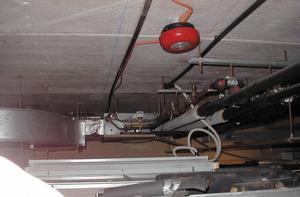The penalties are not small beer. Tender submissions can have cost variations of up to 40%. Pages of qualifications can take days to quantify. With fees being squeezed, speeding up and streamlining the tender appraisal process could therefore produce real savings.
David Witt Associates has had enough of fragmented and uncoordinated tender documentation. For this small building services consultant, every hour an engineer spends away from doing design merely adds to the overheads.
Of course, a design and build contract transfers much of the services co-ordination problems to the main contactor, but this often produces poorly serviced buildings. And clients such as Palace Street Developments require their consultants to accept full responsibility for the design. Quite rightly, they will not accept cost variations due to poor co-ordination.
As an experiment, the eponymous David Witt decided to issue electronic tender documents for Palace's refurbishment of an office block in Reading. Approval for this experiment was given readily, once it was realised that 15 sets of tender documents required some 3000 pages of A4 paper, together with 450 A1 drawings. Not only would this cost £1200, using so much paper can hardly be considered sustainable.
By contrast, the equipment required to produce the documents on CD-Rom comprised a CD writer for £150, 15 blank CD disks at 75 pence each, and a CD labelling machine and blank labels for £15. A conventional desktop computer with 300 Mb of disk space handled the information storage and retrieval.
A dedicated folder was created in Windows, and each section of work was then saved to that folder. A single specification was produced for all the mechanical, public health, electrical and controls works. This saved about a day of preparation and typing.
The vocabulary of the documentation was carefully considered at the start. Multi-service drawings were used, with each service indicated in bold typeface and the other services indicated in a light grey plot.
The ceiling plans indicated the locations of light fittings, grilles, smoke detectors and sprinkler heads. David Witt reasoned that this attention to detail could go a long way to eliminating contractual conflict between the various specialist contractors.
The data itself had to be configured to be accessible by the average contractor – not every company has AutoCAD or Word 2000.
When it was complete, the folder was burnt onto CD-Rom. In all, the CD documentation comprised:
Assembling the information took a day, and burning each CD disk took a lengthy 1 minute 32 seconds. The total cost of doing this was around £500-700 cheaper than the conventional paper-based approach.
The results
Three mechanical contractors, four electrical contractors and two controls contractors responded to the invitation to tender. The cost variation was 9% for mechanical, 3% for electrical and 16% for controls.
The average number of tender qualifications was six for the mechanical package, and four for the electrical package. Neither of the two controls bids came with qualifications.
The presentation itself was well received by the majority of tenderers. One electrical contractor e-mailed the drawings to his print shop, but found that the shop could not read AutoCAD files. The drawings were subsequently issued as plot files rather than drawing files. Another electrical contractor stated that he had no provision for printing cad drawings and requested a set of hard copy drawings.
By and large though, the comments received were said to be "all positive". One contractor claimed that, because the consultant had issued all information sent to other trades, he could not have a claim for extra costs due to inadequate information at time of tender.
And the proof of the pudding? The overall cost of the project was reportedly £5000 less than the budget costs.
The benefits of issuing documents in electronic form doesn't, of course, stop at the tender stage. David Witt Associates has been commissioned to produce record drawings and operation and maintenance manuals.
The site copy of the manual will be produced conventionally and will include reduced A3 copies of the drawings. The manufacturers literature will be scanned in jpeg format, while the text will be saved in Word 6.0/95 format. The record drawings will be saved in a plot file as well as AutoCAD format. Client copies of the manuals will be issued on CD-Rom.
David Witt has estimated that the overall cost savings for the manuals is likely to be in excess of £2000. A small amount perhaps, but given today's fee levels, every little helps.
Source
Building Sustainable Design
Postscript
David Witt Associates is an m&e consultant and design firm based in Finchampstead, Berkshire.




















